The 7 Easiest Old-School Games of All Time
 |
Today’s games are easier than heating up a can of Beefaroni. By and large, they’re painfully simple, obsessed with hand-holding and spoon-feeding us everything so we don’t feel bad after we die 800 times in a row. Whatever happened to the good ‘ol days, when unforgiving enemies, hostile obstacles, no continues, and constantly having to start from the beginning were the norm?
Funny thing – a lot of them weren’t anything close to that. Residing deep at the bottom of the Nostalgia Ocean is the realization that a lot of old-school games were actually quite easy. Like, stupidly so. And some of these incredibly easy games were some of the most popular in history! Games haven’t gotten easier, because they never stopped being so.
7. Final Fantasy VI
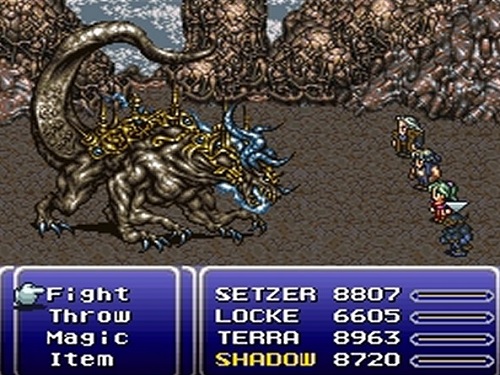 |
Never mind that the game itself took 60-80 hours to complete. Compared to the first five games of the series, Final Fantasy VI was an absolute cakewalk. Why? Because you could literally do anything with any character, and do it quickly to boot.
In past Final Fantasies, characters had jobs and classes that differentiated them from one another. Only one character could cast black magic, one could heal, another could use heavy weaponry, another was a bard whom everyone hated with every drop of blood in their bodies – point being, each character was a unique and special snowflake.
 |
| Though the Bard was more like a heavy pile of muddy slush that soaked your socks and ruined your day. |
But in VI, there were no snowflakes, just identical Big fucking Macs. Every single member of your party could use the same, insanely powerful magic at the same time, and gaining the experience necessary to learn this magic took very little time at all. Imagine if Doom had a dozen Marines, all equipped with unlimited-ammo BFGs halfway through. Same thing.
The most powerful spell was Ultima, which caused maximum damage damn near every time. If only one character had that power, it’d have been one thing. Then you’d have a challenge to keep that one caster alive and casting. Or maybe if everyone could’ve used it, but it cost every single magic point they had. Then you’d have a limit on its usage unless you stocked up on recovery items which, in a difficult game, would be rare finds from start to end.
Neither happened. Instead, everyone could use this spell over and over again, because magic points were numerous and recovery potions were more prevalent than air. This meant that you could simply Ultimagasm until whoever tried to kill you went away. This included the final boss, who you could finish off with a half-dozen Ultimas, no issue.
As awesome as its story was, Final Fantasy VI’s gameplay offered less suspense than an episode of My Little Pony.
6. Wizards and Warriors
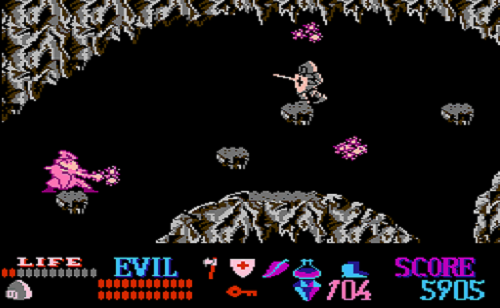 |
Ghosts and Goblins, as any old-school gamer with 30 years of massive therapy bills will attest, was the hardest game on the planet. But Wizards and Warriors, its cousin in the Video Games Named After Stereotypical Fantasy Tropes Family, is the black sheep at every reunion. It was easier than the $100 questions on Toddler Celebrity Jeopardy.
On the surface, W&W seemed like your typical Nintendo Hard game (not to mention what Batman sees when he’s hanging upside down and gets a craving for candy.) The controls weren’t great, enemies flew in from everywhere, three seconds of repetitive music were endlessly looped until you got careless and died due to rage-induced blindness, and you only had three lives to boot. It sure sounds like it caused plenty of premature baldness, so why are we talking about it?
Simple: because you never actually died. EVER. Like that stupid Tubthumping song that you now have in your head, every time you got knocked down, you got right back up again, stronger than ever. Sure you had three lives, but each time you died (even if it means a Game Over,) you started right back where you left off, with all of your items and points intact. It’s like you never died at all! If you’re wondering who to blame for today’s Ratchet and Clank-style games, where you die and re-spawn in the exact same spot like nothing happened, here you go.
To be fair, though, when a boss killed you, it would immediately return to 100% health, so that’s a teensy bit of challenge at least. Sure, it’s like munching on one carrot stick to make up for that entire triple-layer cake you just inhaled, but at least it’s something.
5. Karate Kid
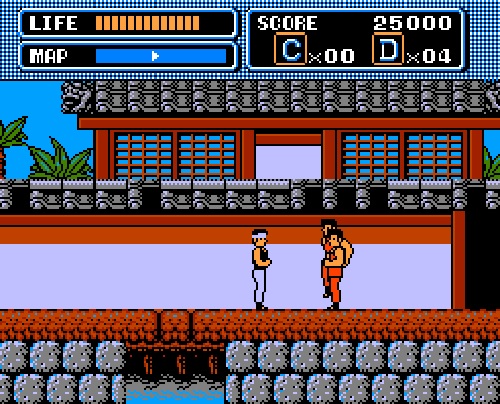 |
Video games based on movies are almost never good, but at least most of them try to make a complete, challenging game before failing miserably. Karate Kid didn’t even bother with THAT. Instead, it upchucked four stages of the easiest, most mind-numbing, most utterly pointless “gaming” imaginable. Or rather three, since Stage 1 was the All-Valley Tournament, where you did nothing but kick your opponents until you win. It took 30 seconds.
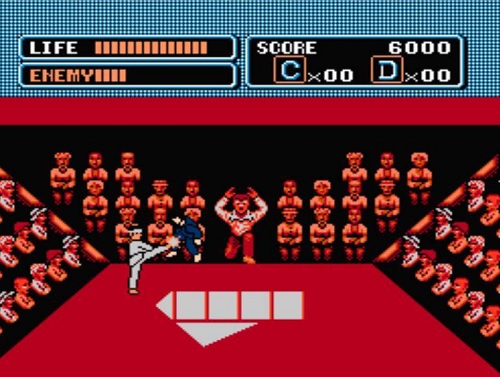 |
| Sadly, anyone who lost this stage didn’t get banned from gaming forever. |
As much of a putrid waste of time as Stage 1 was, it was actually a fine tutorial for the rest of the game. After all, every single enemy that showed up, regardless of which level you were at, could be floored with one kick. They briskly walked towards you, you kicked them, and they dissipated into nothingness. Kicking your cat is more challenging, mainly because the cat will claw at your skull and playfully bat at your exposed brain if you dare try.
Such pointless bullshit might have worked if the bosses were at least capable of sending you to that great waxed car in the sky. Naturally, this didn’t happen. There were only two bosses, and each one upped the challenge ante by requiring three, possibly four kicks before croaking. Other than that, they were no more intelligent or cunning than a Power Rangers Putty battling a severe concussion.
Oh, and on the off chance that an enemy actually hit you, no need to fret – there were more than enough power-ups to go around. You simply kicked until you saw a “C,” grabbed it, and swished all that delicious, delicious health in your mouth.
And if you didn’t want to do THAT, the game offered an even easier victory strategy: run away. Never were there more than two enemies on screen at a time, so if you avoided their frail old man attacks and just walked past them, they’d follow you and NEVER CATCH UP. They didn’t speed up, nor did they call for re-reinforcements; they simply power-walked behind you until they fell into some water. That’s not spoon-feeding; that’s nutrition from an IV drip.
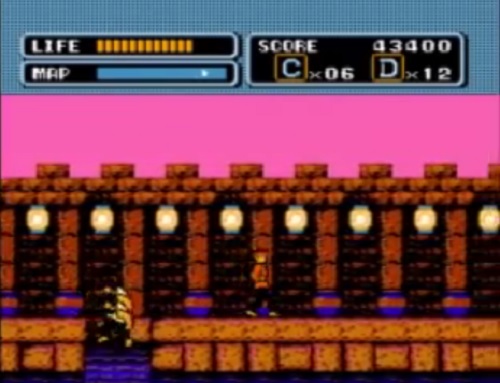 |
| To be fair, if we found water in the desert, we’d be all over that shit too. |
You kept this up until you won the game, a feat that probably took ten minutes tops, and that’s including the pointless bonus rounds. Literally the only challenging part of this thing was figuring out that you jumped by pressing up, something the manual told you anyway. Get it? Because you jump UP, therefore you PRESS up as well. That’s a pretty funny joke, especially if the punchline is “and they immediately fired the douchebag responsible.”
4. Guerrilla War
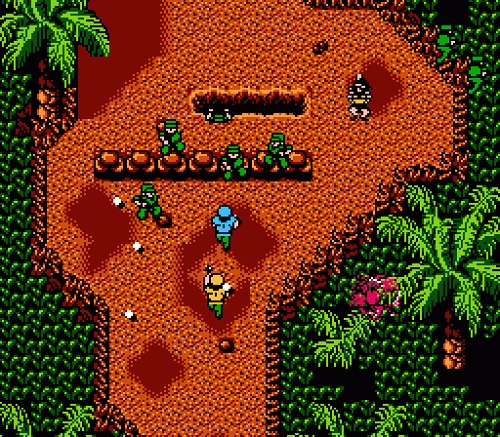 |
Here’s a game that, before Nintendo and company got their mitts on it, was a normal old-school game that was just hard enough to make you question what loving God could so cruelly create such an instrument of torture, but not so hard you didn’t want to play anymore. After all, it was an arcade game, and its existence depended on kids dropping quarter after quarter until they finally got past that one aggravating soldier who kept gunning them down.
If that wasn’t enough, you got to play as Che Guevara and Fidel Castro, out to liberate Cuba from the clutches of Fulgencio Batista. Now granted, this ended up being the Rat King and Baxter Stockman teaming up to overthrow Shredder, but it was still novel and cool.
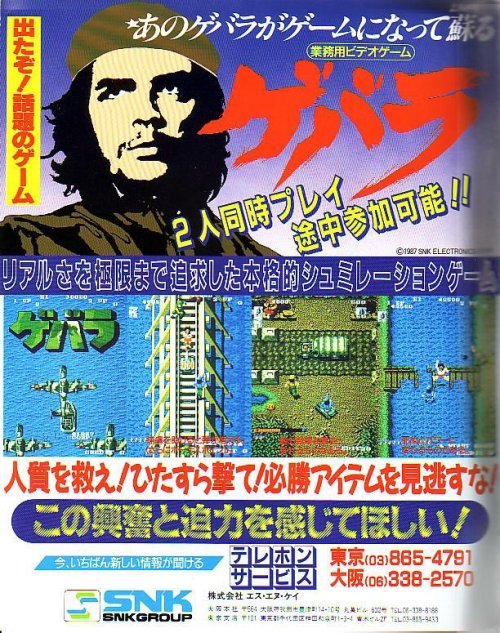 |
| No adventure is complete without Freshman Dorm Room Poster Guy at your side. |
Once Nintendo ported the game though, both features changed. Guevara, Castro, and Batista became anonymous, likely due to both politics and Nintendo thinking we were all idiots who didn’t know anyone if they weren’t ‘murcan. But more importantly, the challenge level dropped significantly, to the point where anybody could play it. Even Guevara himself, who sadly never really found the time for gaming.
The game played much like the arcade game, in that enemies were everywhere and you died a lot. However, since NES systems didn’t accept quarters no matter how much your evil baby sister insisted they did, it couldn’t exactly charge you to continue. It got around that by … offering unlimited continues. And each time you died, you picked up right where you left off. It was Wizards and Warriors all over again!
Oh, and your ammunition was unlimited too, meaning you just held the shoot button and pressed forward until you win. If you Game Over’d, you just kept going. Literally the only thing you lost were points, so if those numbers were actually a big deal to you, then sure, whatever. This game was harder then ten Contras combined, blah blah yak yak.
For the rest of us, you weren’t controlling a revolutionary soldier, but a mindless, invincible zombie that never died and never will, no matter what others may do to it. Which, come to think of it, would explain how the fuck Castro’s still kicking.
3. Barney’s Hide and Seek Game
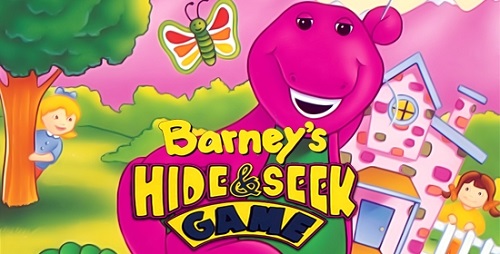 |
It might not surprise you that a video game starring a character most four-year-olds find an insult to their intelligence isn’t that hard. But compared to Barney’s Hide and Seek, games like Sesame Street 1-2-3 were goddamn Battletoads.
In a way, Barney is the grandfather of every single new-school game that spoon-feeds you every last morsel until your guts explode from all the win. But in this case, Grandpappy’s far worse, because at least you CAN lose a spoon-feeding game if you really want to. Barney? You couldn’t lose. AT ALL. The stated goal of the game – find all the hidden children – did not matter, because you won no matter how poorly you did. Whether you found zero children or all five, you could cross the finish line and Barney would insist you did a super-dee-duper job.
 |
| The fewer of these brats you picked up, the more super-swell your life became. |
But wait, there’s less! Let’s say you took too long to move Barney around. Maybe you forgot to pause while going to the bathroom, or while calling Grandma to yell at her for buying you this piece of crap even though you were 15. How did Barney react? By playing his own game, that’s how! If you took too long to move his swollen grape-looking ass anywhere, he would actually walk to the finish line by his lonesome. And once again, it didn’t matter how complete your kiddie collection is, Barney still proclaimed you did a super-dee-duper job.
But wait, there’s even MORE less! Turns out, Barney couldn’t die. He would not walk off a cliff, no matter how much you begged and begged. Instead, he would do this:
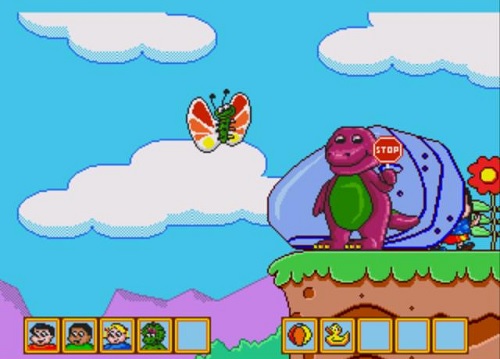 |
That’s right: Barney would flash a stop sign and claim he could not proceed until it was “safe to do so.” Only once a platform appeared could you actually control him again. So if you were so bad at games that every time your character went near a cliff, they were guaranteed to go splat at the bottom (or fall forever, depending on how you view video game pit physics), Barney was the game for you.
If, on the other hand, you bought the game purely to violently murder Barney like a normal child would, this was so not for you. You’d just have to keep on imagining his slow, brutal demise, much like every night.
2. Altered Beast
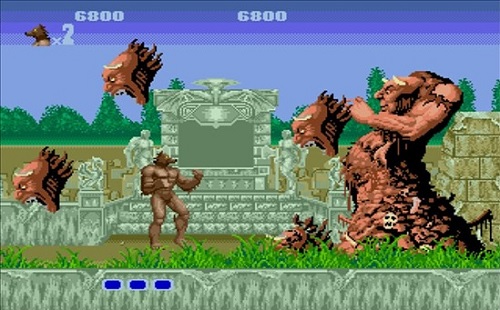 |
Most old-school gamers played this title, mainly because it came packaged with the Sega Genesis and did the trick until we finally annoyed our parents enough so they’d buy us Sonic. As such, many of us have fond memories of Beast, though mostly due to its kitsch factor. Even if the game was literally nothing but hour after hour of “WISE FWON YO GWAVE,” “POWA UP,” “WEHCUM TOO YO DOOOM,” and the goddess Athena making love to a fucking werewolf, we’d be happy.
 |
| And here you thought Zeus was the only perv on Mt. Olympus. |
It’s a good thing such ridiculousness was included, because the actual game was easy as pie, though not nearly as tasty. There were five stages, and each one was super-short. If it weren’t for the Invisible Scrolling Wall of Interminable Slowness stopping you, you could probably zoom to the end of the game in five minutes flat. Instead, you had to spare ten, possibly fifteen minutes to conquer this epic. Suck it ,Atreyu – this is the REAL Neverending Story!
And it’s not like that brief period of playtime was filled with death and doom and danger lurking around every temple and monument. Nope – the enemies were slow, weak, and didn’t get any faster or stronger as you progressively powered up. In fact, other than when you turned into a mythical beast, all power-ups were completely useless. At your weakest, two hits were required to make a foe crumble, though usually you only needed one.
As for the bosses, these might have been the most pathetic bosses in gaming history. You could destroy each and every one in seconds flat, simply by spamming your special Beast move over and over again. If you somehow died while doing this, you would immediately come back to life with full health, while the boss’s health remained unchanged. That’s like winning a basketball game, only for your opponent to immediately start a rematch where they’re up 115-2 at tip-off.
1. Super Metroid
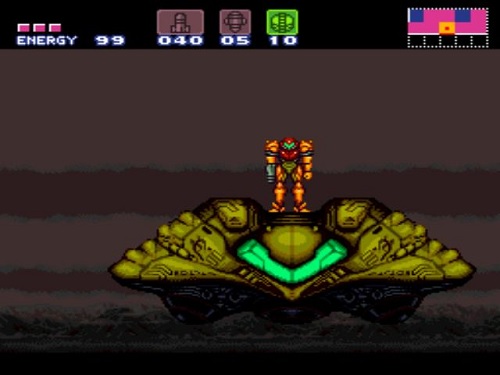 |
Much like with Final Fantasy VI, sometimes our love for an unabashed classic can cloud our judgment of it. Such is the case with Super Metroid, one of the greatest, most influential, and – unfortunately – easiest games in history.
Samus Aran, already a battle-hardened warrior, was now so vastly overpowered that winning was practically a foregone conclusion. You had over double the items you had in the original Metroid, including super missiles, super bombs, a stupidly high jump, four new beams, tons more energy (including reserve energy for when you run out of real energy), and so much more.
Shockingly, there was no mega-super-ultra-giant-huge bomb that could explode the entire planet before the game even began. Maybe the developers decided that would be cheating?
In addition, this game was the originator of the map-out-everything trope that Castlevania appropriated several years later. With the original Metroid, there was no map, which forced you to actually explore and remember where you’d been and how you got there. Unless, of course, you were so meticulous that you could actually draw your own map. More often than not though, any attempt at doing so immediately resembled a series of kindergarten-esque scribbles, the paper liberally spiced with every curse word we had heard of up until that point.
But with the map, we always knew exactly where we were at all times, and exactly how to get to where we needed to be. It all but eliminated the thought process required in the original Metroid. A lack of map may have made the game harder to beat, but that was also kind of the point.
Then of course, there was the final boss. Except Super Metroid didn’t really have a final boss, did it? Mother Brain’s new body sure looked scary (not to mention a little curvy,) but she was little more than a storyline battle that you legitimately could not lose.
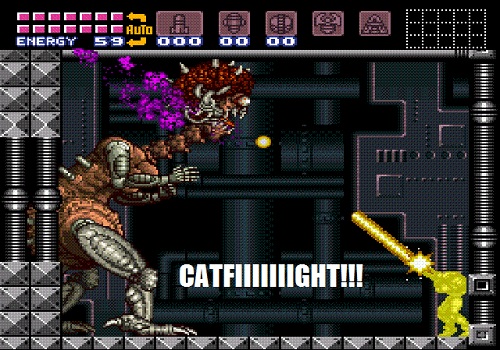 |
Even if somehow you lost a ton of energy in the almost-battle, the game would just skip straight to the part where the Baby Metroid sacrifices itself and bequeathed you yet one more beam that will absolutely obliterate Mother Brain and leave her a mere pile of dust.
That’s right – one of the most beloved videogames of our childhood ended up being almost as predetermined as Barney’s Hide and Seek. How super-dee-fucking-duper.
Previously By Jason Iannone:
8 Possible Superman vs. Batman Casting Decisions That Would Make the Internet Explode in Rage
7 Awesome Videogame Plot Twists That Were Never Followed Up On
9 Gag-A-Day Comic Strips That Got Weird Once People Stopped Reading
Nine ’80s Franchises That Never Got (even a Crappy) Videogame but Should Have
Related Posts
-
Portal: Still Alive Comes Alive Today (Updated)
FYI, the Portal prequel Still Alive is available for download on
by Rob Bricken -
 Posable Heroes: Paper, Physics, and Puzzles | BACKLOG.TXT
Posable Heroes: Paper, Physics, and Puzzles | BACKLOG.TXTToday's BACKLOG.TXT takes a look at a promising hidden indie puzzler:
by Chandon Kunz
